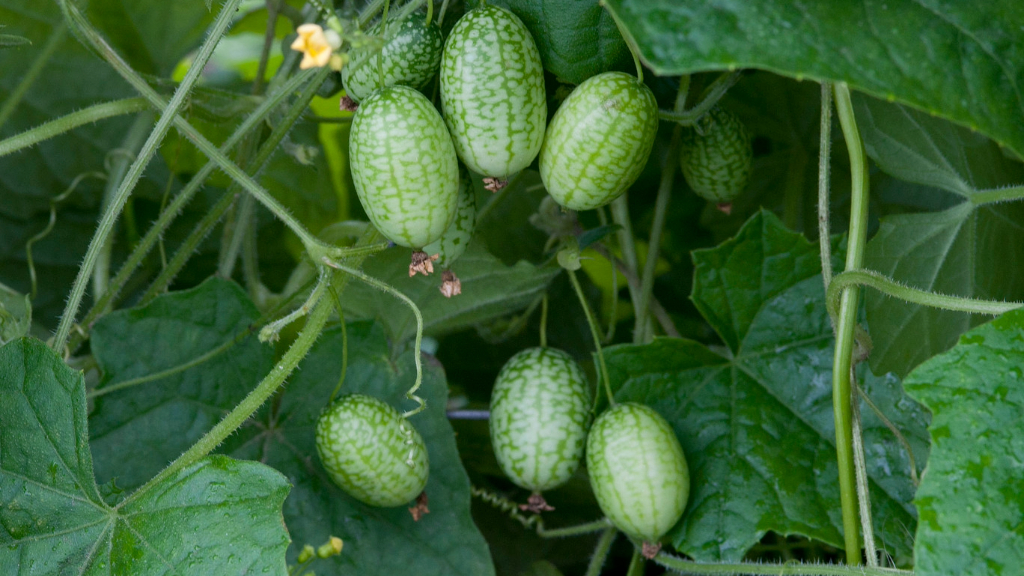Learn About Mexican Sour Gherkin Cucumbers


Having trouble getting your family to eat vegetables? One interesting and fun way to increase consumption is to try unique and quirky options. Mexican sour gherkin cucumbers fruit in 75 days and are easy to grow in warmer climates or areas with long, hot summers. Strangely enough, these little fruits aren't technically cucumbers at all but carry an honorary designation due to their similarities to that popular fruit. With its lemony flavor, adorable packaging and variety of uses, Mexican gherkins (Melothria scabra) are a great way to increase produce diversity in your home and possibly appeal to some of the picky eaters therein.
What is a Mexican Sour Gherkin?
This plant is an heirloom that hails from Mexico and Central America. It bears several colorful common names based on its appearance such as Cucamelon, Mouse Melon, and Little Watermelon.
Mouse Melon history is complex due to its incorrect classification as a cucumber but it is also not a melon. The plant belongs in the Cucurbitaceae family, which does encompass gourds, melons, and cucumbers. Technically, however, the Mexican sour gherkin is more closely related to fruits from Africa and its classification varies from botanist to botanist. Wherever the plant fits in, it's a delightful edible with a myriad of uses from fresh to pickled and even in stir fries.
Mouse Melons look like you took a full sized watermelon and put it in the machine they used in "Honey, I Shrunk the Kids." Some even refer to it as Barbie Melon because it is the perfect size to use when playing with those popular dolls. The leaves are very similar to cucumber leaves but a bit smaller and bear the same sticky, hairy stems which curl and grasp as they grow.
The flowers are also similar and become tiny, less than 1-inch long fruits with speckled skin of dark and lighter green. The flesh is fresh, juicy, and sweet with a hint of citrus and you can eat the entire thing, skin and all. Many growers use the fruits in salad as you would a regular cucumber but they can also be sliced up and added at the last minute to a quick stir fry.
Growing Mexican Sour Gherkins
Growing Mexican sour gherkins is very similar to cultivating any cucumber or melon. They need full sun, well-draining soil, and even moisture. In cooler regions, start seeds indoors 6 weeks before the date of your last frost. Seeds germinate in about 10 days and should be hardened off and planted out 9 to 12 inches apart. Vines may get as tall as 10 feet so it is a good idea to provide a trellis or cage to which the plant can adhere.
Fruiting can start as early as July and last until September since they are actually more cold tolerant than many cucumber varieties. The standard cucumber pests and diseases apply. Avoid overhead watering to prevent mildew issues and watch for cucumber worms.
Sign up for the Gardening Know How newsletter today and receive a free copy of our e-book "How to Grow Delicious Tomatoes".
If you can't source seed yourself, perhaps you are lucky enough to find someone who has grown them and saved seeds. Seeds are prolific and readily viable for a couple of years.
To harvest seeds, split open very ripe fruit and scoop out the seeds. Place seeds and pulp in water for up to 5 days. This will slightly ferment the pulp and cause foam on the top of the container. Rinse the seeds in a colander several times and then spread them out to dry on a screen in a warm location. Seeds are ready for storage when they are completely dry and should go into glass jars for long term storage in a cool, dark place. In this manner, you can have a ready supply of Mouse Melons even in northern climates.
In warm regions, the composting dropped fruit will readily sprout the next year and self-seed themselves. These marvelous melon-like-cucumber-ish fruits are a hit with kids and adults alike. Find yourself some seed before the next growing season and enjoy these quirky, ornamental little plants.
